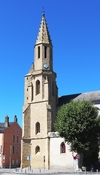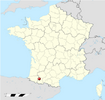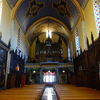Perhaps just snippets showing the visual difference they refer to; would be interesting to view the development. Good idea.I can try scan the chapters from both books if you are interested.
You are using an out of date browser. It may not display this or other websites correctly.
You should upgrade or use an alternative browser.
You should upgrade or use an alternative browser.
Cathedrals and churches
- Thread starter stellar
- Start date
It's an interesting question I think, and I suppose there's a few things we can probably deduce right off.What was the intended original purpose behind their construction? Did the elaborate, coloured floral shaped windows have any functional significance other than aesthetics? Similarly, did the great organs have anything significant to do with resonance other than playing loud music?
Cathedrals were perhaps the symbol of the connection of the rulers with god, which many probably felt had abandoned them, they were also sources of monetary exchange, and reasons to visit a town which has it's own monetary benefit, even to this day we visit countries and towns because of their architectural beauty.
There was probably, after the plague, a wish for things to go back to "normal" and so that was probably married with some social factors (some above) and the ruler's ego of needing to have an attraction in their town to rival their neighbors.
Having said all of the above, I do wonder if by design or accident, some of these buildings may have been capable of collecting some energies of those who attended them regularly, specially if they were coming out of an era where things felt hopeless, I can imagine the emotional energy that was generated by those who put their hopes in the church. All of the above is of course speculative. But it is an interesting idea to ponder about.
I am reminded of how during the French Revolution, they turned Notre Dame in Paris from a cathedral to a "temple of reason"Could it be along the current modern lines of Renaissance = a type of Wokism with man at the center of the universe, a supposed “freedom from God” whereas Gothic = traditional, classical conservative spiritual values?
That's the ingrained concept and definition we have today and I'm questioning it. Was it ever something else, I have to wander.Cathedrals were perhaps the symbol of the connection of the rulers with god,
Nević Nenad
The Living Force
Dont forget that the organs were invented by Byzantines. To cheer up the crowd at horse races. Then brought to Europe by catholic crusaders (among many other things). Thats for "sacred and divine" music in western Europe's cathedral . . . .
BHelmet
The Living Force
Since the title is cathedrals and churches I think it’s best to limit the scope to that. If temples from BC are included, it would tend to water down the investigation, I think, and I don’t see the original idea of this thread as going back that far.The answer to your questions requires some study. All resources are on Archive.org.
Re: Re Fomenko and History books, irrespective of how one looks at 'it', buildings were constructed, in Christian architecture, Byzantine architecture and Romanesque architecture before the Gothic architecture. As far as Roman architecture as a somewhat pinnacle of sorts one should start at least a couple of thousand years earlier, in the B.C. era with the Greek architecture.
Nević Nenad
The Living Force
Atlantean energy conduits? But, what we see now are just the spires. The rest is underground, and put there by the massive mud floods made with the secret Lemurian weapon?That's the ingrained concept and definition we have today and I'm questioning it. Was it ever something else, I have to wander.


If we didn't lough about our state of affairs, we'd go crazy, right? Gotta have some fun while learning.Atlantean energy conduits? But, what we see now are just the spires. The rest is underground, and put there by the massive mud floods made with the secret Lemurian weapon?

As for Atlantis, not sure I should reach that far. As for hidden knowledge, maybe some grains here and there are possible.
BHelmet
The Living Force
I think it is important to remember why, in the USA, they were so adamant about the separation of church and state. Monarchies ruled by the "divine right of kings". It was a tag team relationship between the church and the state...a two-headed behemoth before which all had to bow down, one way or another. The monarchies ("l'etat") derived their legitimacy from the church and the church got heavily involved in secular power politics. The church and state were two power hungry heavy-weights that worked together against "we the people", but often wrestled for power, forming various alliances, playing favorites, fighting wars etc. So the story goes.It's an interesting question I think, and I suppose there's a few things we can probably deduce right off.
Cathedrals were perhaps the symbol of the connection of the rulers with god, which many probably felt had abandoned them, they were also sources of monetary exchange, and reasons to visit a town which has it's own monetary benefit, even to this day we visit countries and towns because of their architectural beauty.
I am reminded of a candid quote from the Irish Monsignor who married my wife and I:
"The closer you get to the altar, the further you get from God"
(he was referring to going up the church hierarchy, IOW, the deeper you go into the workings of the church, the dirtier it gets)
That's a good point, and going back to the initial question I suppose that cathedrals would have been a building, whether by design or accident, where a certain energy was concentrated by human activity and their focus.I think it is important to remember why, in the USA, they were so adamant about the separation of church and state. Monarchies ruled by the "divine right of kings". It was a tag team relationship between the church and the state...a two-headed behemoth before which all had to bow down, one way or another. The monarchies ("l'etat") derived their legitimacy from the church and the church got heavily involved in secular power politics. The church and state were two power hungry heavy-weights that worked together against "we the people", but often wrestled for power, forming various alliances, playing favorites, fighting wars etc. So the story goes.
I must also say that there's another aspect to most cathedrals, medieval cathedrals, that I have visited, and the incredible amount of human beauty to be found in them is almost overwhelming. I think JPB mentioned it once, how the beauty of these amazing buildings were a testament to the incredible conscious effort of many human beings. So there's that as well.
So, I suppose it could be a bit of both.
BHelmet
The Living Force
I totally agree. I did not mean to suggest that the cathedrals were a locus of power politics. I agree with Fulcanellis point (and yours) that the cathedrals themselves express something divine and awesome. Once again it becomes a matter of juggling what we actually see versus the narratives. And it seems there are large parts of the narratives that are just missing.I must also say that there's another aspect to most cathedrals, medieval cathedrals, that I have visited, and the incredible amount of human beauty to be found in them is almost overwhelming. I think JPB mentioned it once, how the beauty of these amazing buildings were a testament to the incredible conscious effort of many human beings. So there's that as well.
Old Churches, wherever they are, contain a reverent energy manifested from the hopes and sorrows of humanity. I have especially felt this in Mexico. I was lucky enough to visit the Basilica of Guadeloupe back in the 70’s when the famous tilma was still just hanging there, no glass case’ no armed guards. (Now it’s more like being displayed like a Museum Piece in a modern building with tickets and long lines and limited time to contemplate). Anyway, I was a callow youth of 16 or 17 but I was dumbstruck into silence by the sight of an old woman kneeling/walking on bloody knees across the plaza of Aztec stones to approach The ancient basilica to pour her heart out in supplication to the Virgin Mary. That kind of thing multiplied countless times for hundreds of years leaves an indelible imprint.
Olivierlejardinier
Jedi Council Member
Here's a somewhat "iconic" Roman style cathedral in France (wikipedia Le Puy Cathedral), built in an early christianized location.Perhaps posting a few pics of these stylistic differences
"A town called Anicium existed on the site since at least the 6th century. Fragments of Roman temple sculpture were reused in the walls of the cathedral, and Roman funeral monuments, and Paleochristian sculpture other artifacts have been found nearby. These fragments mention the name of an early bishop, Scutaire, and date from late antiquity and the early Middle Ages. (They are now found in the Crozatier Museum in Le Puy).[1]
Documents from the period indicate that the early Christian church contained a celebrated image of the Virgin Mary and child, made of ebony, according to some sources, The statue was dressed in gowns made of gold and other precious fabrics. The cult of the so-called Black Madonna was found in many other French churches of the time, and helped attract pilgrims. The original statue was destroyed in 1794 during the French Revolution, but many illustrations of it still exist. It was replaced in the 19th century by a new statue, now on the altar.[2]
Beginning in the 10th century Le Puy became a major stop on the pilgrimage route to Santiago de Compostela. With the influx of pilgrims, the size of the cathedral chapter grew to forty priests, and the chapter constructed an "Hôtel-Dieu" or residence for impoverished pilgrims. A large number of chapels, convents, schools and other religious institutions were founded around the cathedral as a consequence of the pilgrimage.[2]"
The west façade :

A general view in the city:

I'll let someone else illustrate 'gothic style' as I'm not familiar enough with it...
A thought, buildings' evolution/improvement during history follow closely these of blacksmithing and metallurgy , more available and better steel enabled "progress" in many domains...
Yesterday I was near Trabes and took a monument to step into one of the many local churches in this city.Perhaps posting a few pics of these stylistic differences (which may also reflect psychic and other differences) would be a nice service. It does seem like there are style categories that may or may not relate to time periods as well.
To quote Wiki:
Galerie d'images

Historique:
Eglise Sainte-Thérèse de Tarbes interiorLa nouvelle église a été inaugurée en juillet 1845, elle devient alors église paroissiale et c'est à cette date qu'elle change de nom pour passer d'église des Carmes à église Sainte Thérèse d'Avila.L'église actuelle correspond à l'église de l'ancien couvent des Carmes de Tarbes fondé en mars 1280. La première église, dont sont issues la majeure partie des façades, a fait l'objet d’importants travaux à la suite de plusieurs incendies. Les réseaux de pierre des baies du chevet en témoignent, mais également une fenêtre géminée en façade ouest, inscrite dans la rose initiale.Après la Révolution l'église est transformée en magasin à fourrage. A ce titre, une porte est ouverte en 1838 dans la façade Nord, provoquant l'effondrement de cette dernière. Après ce sinistre, l’église est reconstruite en mars 1845.Malgré de nombreuses transformations, l’édifice actuel présente une grande homogénéité, laquelle résulte de l’adjonction soignée des ouvrages reconstruits sur les parties médiévales conservées.L'édifice est inscrit au titre des monuments historiques le 27 février 19461.
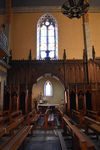
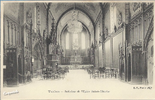
Pipe Organ

Paintings

Français : Peinture de Église Sainte-Thérèse de Tarbes : Le portement de croix, Raymond-Marc Lagarrigue, 1856. Copie d'une toile de Raphael réalisée vers 1516-1517 pour le monastère olivétain de Santa Maria dello Spasimo de Palerme et conservée au musée du Prado.
Statues
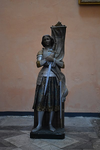
Eglise Sainte-Thérèse ou des Carmes Français : Intérieur de l'Église Sainte-Thérèse de Tarbes.
Attachments
Indeed, which perhaps leads to the possibility that cathedrals can be a tool, beautifully constructed but like any other tool their use may change from time to time depending on who wields them.I totally agree. I did not mean to suggest that the cathedrals were a locus of power politics. I agree with Fulcanellis point (and yours) that the cathedrals themselves express something divine and awesome. Once again it becomes a matter of juggling what we actually see versus the narratives. And it seems there are large parts of the narratives that are just missing.
Perhaps to draw an analogy that may apply, it's like a Katana, the technique into making them is awe inspiring, and the culture and discipline could almost give one the notion that something so beautiful could never be used for nefarious purposes, but then you learn about the history of some of the behavior of samurai at the height of their power and you realize that these beautiful tools, were used for nefarious purposes, beyond war and survival.
So, perhaps something similar can be extrapolated to cathedrals, albeit at a different level, a tool that requires beauty to function properly, which means it needs creative energy and effort and discipline, but that can be welded by evil for their purposes.
This discussion reminds me of an ex archeologist (disgusted by the field that once made him dream) I listened to the other day, and I will paraphrase his main points, which I think are worth to keep in mind:
- archeologists, historians, and art historians don't have the same jargon ; it doesn't help
- an excavated site is forever lost afterwards, especially if it's not well done, and even more in case of preventive archeology
- the system is so (he talked about France and unfortunately, I guess it would apply for other countries too) that we can't expect any revelation from archeology anymore. All is already categorized, they aren't interested in discovering new things, just corroborating and never questionning what has been established before
- he gives an exemple of a site where roman and medieval artefacts were mixed (yes, interesting, and there are a lot) with some peculiar structure which was at odd, and was forbidden to investigate it more, the structure in question won't even be mentionned in further reports and papers, and nobody will never know...
For French speakers, here is the interview
- archeologists, historians, and art historians don't have the same jargon ; it doesn't help
- an excavated site is forever lost afterwards, especially if it's not well done, and even more in case of preventive archeology
- the system is so (he talked about France and unfortunately, I guess it would apply for other countries too) that we can't expect any revelation from archeology anymore. All is already categorized, they aren't interested in discovering new things, just corroborating and never questionning what has been established before
- he gives an exemple of a site where roman and medieval artefacts were mixed (yes, interesting, and there are a lot) with some peculiar structure which was at odd, and was forbidden to investigate it more, the structure in question won't even be mentionned in further reports and papers, and nobody will never know...
For French speakers, here is the interview
Yup. If you're not in the club of groupthink, and they are numerous, you will remain unsuccessful; whatever that really means.we can't expect any revelation from archeology anymore. All is already categorized, they aren't interested in discovering new things, just corroborating and never questionning what has been established before
Once upon a time that was my dream career. My eldest son's was to be a doctor. We both at different times concluded these were clubs we did not need to be part of. The price of denying self was, by far, not worth it.

